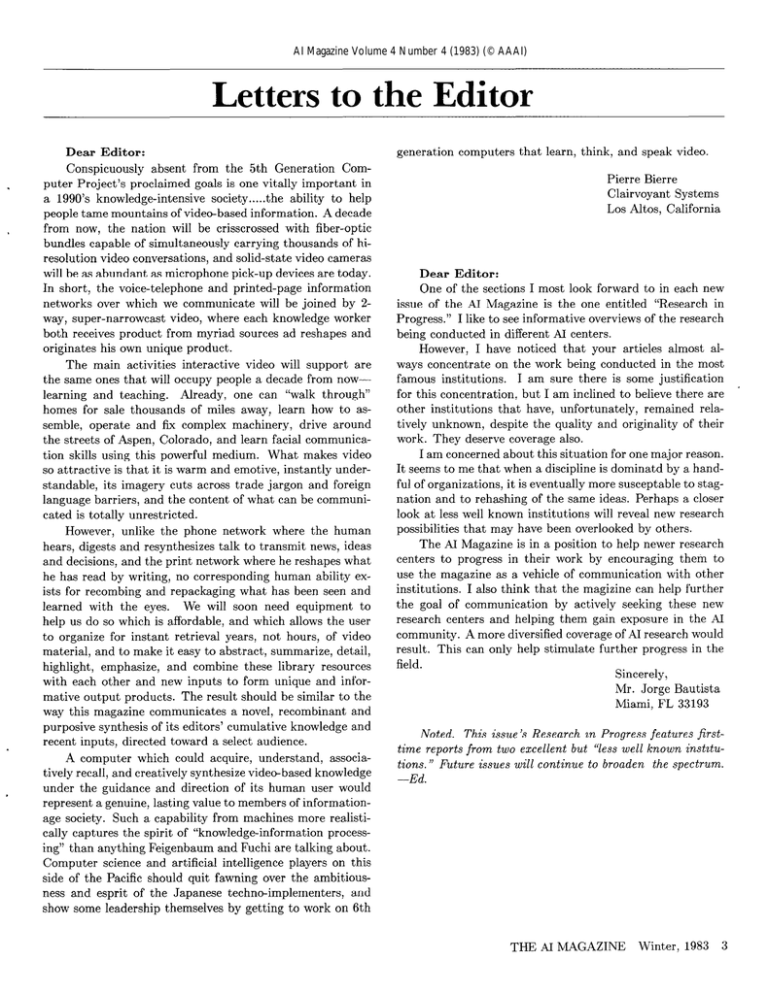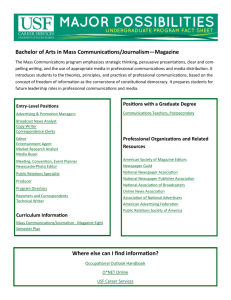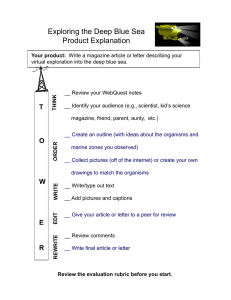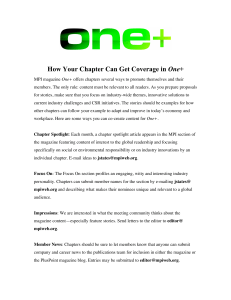Letters to the Editor -
advertisement

AI Magazine Volume 4 Number 4 (1983) (© AAAI) Letters to -the Editor Dear Editor: Conspicuously absent from the 5th Generation Computer Project’s proclaimed goals is one vitally important in a 1990’s knowledge-intensive society.....the ability to help people tame mountains of video-based information. A decade from now, the nation will be crisscrossed with fiber-optic bundles capable of simultaneously carrying thousands of hiresolution video conversations, and solid-state video cameras will be as abundant as microphone pick-up devices are today. In short, the voice-telephone and printed-page information networks over which we communicate will be joined by 2way, super-narrowcast video, where each knowledge worker both receives product from myriad sources ad reshapes and originates his own unique product. The main activities interactive video will support are the same ones that will occupy people a decade from nowlearning and teaching. Already, one can “walk through” homes for sale thousands of miles away, learn how to assemble, operate and fix complex machinery, drive around the streets of Aspen, Colorado, and learn facial communication skills using this powerful medium. What makes video so attractive is that it is warm and emotive, instantly understandable, its imagery cuts across trade jargon and foreign language barriers, and the content of what can be communicated is totally unrestricted. However, unlike the phone network where the human hears, digests and resynthesizes talk to transmit news, ideas and decisions, and the print network where he reshapes what he has read by writing, no corresponding human ability exists for recombing and repackaging what has been seen and learned with the eyes. We will soon need equipment to help us do so which is affordable, and which allows the user to organize for instant retrieval years, not hours, of video material, and to make it easy to abstract, summarize, detail, highlight, emphasize, and combine these library resources with each other and new inputs to form unique and informative output products. The result should be similar to the way this magazine communicates a novel, recombinant and purposive synthesis of its editors’ cumulative knowledge and recent inputs, directed toward a select audience. A computer which could acquire, understand, associatively recall, and creatively synthesize videobased knowledge under the guidance and direction of its human user would represent a genuine, lasting value to members of informationage society. Such a capability from machines more realistically captures the spirit of “knowledge-information processing” than anything Feigenbaum and Fuchi are talking about. Computer science and artificial intelligence players on this side of the Pacific should quit fawning over the ambitiousness and esprit of the Japanese techno-implementers, and show some leadership themselves by getting to work on 6th generation computers that learn, think, and speak video. Pierre Bierre Clairvoyant Systems Los Altos, California Dear Editor: One of the sections I most look forward to in each new issue of the AI Magazine is the one entitled “Research in Progress.” I like to see informative overviews of the research being conducted in different AI centers. However, I have noticed that your articles almost always concentrate on the work being conducted in the most famous institutions. I am sure there is some justification for this concentration, but I am inclined to believe there are other institutions that have, unfortunately, remained relatively unknown, despite the quality and originality of their work. They deserve coverage also. I am concerned about this situation for one major reason. It seems to me that when a discipline is dominatd by a handful of organizations, it is eventually more susceptable to stagnation and to rehashing of the same ideas. Perhaps a closer look at less well known institutions will reveal new research possibilities that may have been overlooked by others. The AI Magazine is in a position to help newer research centers to progress in their work by encouraging them to use the magazine as a vehicle of communication with other institutions. I also think that the magizine can help further the goal of communication by actively seeking these new research centers and helping them gain exposure in the AI community. A more diversified coverage of AI research would result. This can only help stimulate further progress in the field. Sincerely, Mr. Jorge Bautista Miami, FL 33193 Noted. This issue’s Research an Progress features firsttime reports from two excellent but Yess well known instztutions. ” Future issues will continue to broaden the spectrum. -Ed. THE AI MAGAZINE Winter, 1983 3 ’






